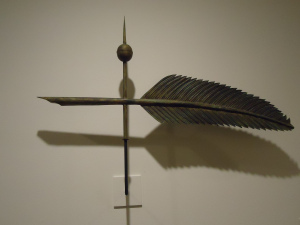Weathervanes … Which Way Is the Wind Blowing?
Lea Wait, here. Most people of “a certain age,” including me, immediately recognize Bob Dylan’s famous line from his Subterranean Homesick Blues (1965): “You don’t need a weatherman to tell which way the wind blows.”

Unusual Quill Pen Weathervane
I think of that line often, especially when I think of those devices that actually DO tell you which way the wind blows: weathervanes. As an antique dealer (one of the hats I grew up wearing, since my mother and grandmother were also antique dealers,) antique weather vanes were part of my world from an early age. Over the years, as folk art became a valuable commodity, nineteenth century weathervanes became more and more difficult to find. A few years ago there was even a group of weathervane thieves operating in the northeast and middle states who audaciously brought ladders to unoccupied homes and barns and stole weathervanes.
There was a good reason for that. Antique weather vanes, especially unusual ones in good condition, can bring $75,000 or up at an auction or antique show. Today several companies reproduce them, so almost anyone can add one to their property. But it’s the old ones that are most fascinating.
Before 1850 most weathervanes were made by hand out of copper, iron, zinc, or even wood. Since farmers and mariners were the most interested in winds, figures of animals (horses, cows, pigs, roosters) or ships were common subjects. But after the Civil War, and the industrial revolution, several New England companies began mass producing weathervanes of copper, first hand hammered or pressed into molds, and then the two sides soldered together. An antique weathervane of that period usually spent many years out in the elements, doing its job, so most are green, the verdigris patina of old copper. A few that were originally hand painted may retain some traces of paint.
During the later part of the nineteenth century weather vanes were made not only in traditional styles, but also included racing horses, trains, Indians, flags … in short, anything that took the fancy of the manufacturer and buyer. The value of a weathervane depends on its age, its condition, and whether or not it is a usual or unusual shape. Modern reproductions are common today, so weathervanes are one of the antiques I would never buy; I’m just not educated enough to be able to know the true difference between old and reproduced. If you want to purchase a genuinely old one, be sure to make your purchase from a well-known dealer who knows their stuff.
There’s a weathervane on my barn today, though. It’s a horse, and it’s modern . . . made in the 1970s. One of my sisters gave it to my mother. As many weather vanes do, though, it has a story. My mother was very concerned that her weathervane would be stolen because, although it wasn’t old, it was a reproduction, and thieves probably couldn’t tell the difference from the ground. Sure enough, one year she returned to Maine after visiting me in New Jersey and the weathervane was gone. She mourned it, and often thought of replacing it, but never did.
In 1998 I moved to Maine full-time, in part to take care of my mother, then in her late eighties. Our neighbors to the north, a couple in between my mother’s age and mine, owned a home whose back faced the back of ours. My mother’d had a minor feud with them years before, so between that dispute and geography, we seldom saw them. But since they had a pier and dock and I had a dingy I wanted to get in the water, I made friends with them. After my boat was established at their pier we’d often chat as I came and went to go rowing.
One day the woman said, “You know, we have your weathervane.”
I couldn’t believe my ears. Twenty-five years after it had disappeared? She smiled. “One winter we had an awful nor’easter, and it blew off your barn and onto our property. So we took it and put it in our back shed. Would you like it back?”
I assured her I would. I never asked her why she hadn’t volunteered the information years before. I knew the answer. We’d never asked her.
So … the weather vane is now back on the barn. It just took a few year sabbatical in the neighbors’ shed.
And now we know for certain which way the wind blows.
Lea Wait's Blog
- Lea Wait's profile
- 506 followers



